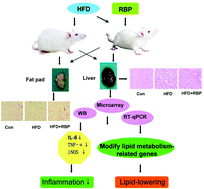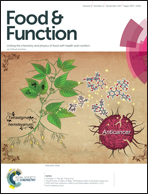Anti-hyperlipidemic effect of rice bran polysaccharide and its potential mechanism in high-fat diet mice
Abstract
Hyperlipidemia occurs very often in modern society along with a high calorie intake and is regarded as one of the greatest risk factors for the prevalence of cardiac vascular disease (CVD). In this study, we investigated the anti-hyperlipidemic effect of the rice bran polysaccharides (RBP) and its mechanism in a high fat diet animal model. 60 ICR mice were randomly divided into 3 groups, which included Control, HFD (high fat diet) and HFD + RBP, and each group included 20 mice. The control group was fed with a standard diet while the other two groups were fed with HFD. In addition, the HFD + RBP group was fed with 500 mg kg−1 of rice bran polysaccharides by intragastric administration while the other two groups were intragastrically administered with water. The results showed that RBP treatment for 10 weeks obviously decreased the body weight, liver weight and adipose tissues of mice; and it decreased the levels of total cholesterol (TC), triglycerides (TG) and low density lipoprotein–cholesterol (LDL-c) in the plasma. H&E staining of the liver tissues showed that RBP treatment decreased the size of fat droplets compared with the HFD group. Microarray analysis revealed that RBP treatment results in 80 genes being up-regulated while 72 genes were down-regulated in the tissues of liver. IPA software analysis suggested that NF-κB may play a vital role in the lipid-lowering effect of RBP. Real-time quantitative PCR confirmed that the mRNA levels of PPAR-α, PPAR-γ, PPAR-δ, SREBP-1C, FASN, ACC, SIRT and CD36, which are related to lipid metabolism, were significantly regulated by RBP supplementation compared to HFD. The western blot analysis further confirmed these altered expressions after RBP treatment. Taken together, these results suggest that the oral administration of RBP exerts lipid-lowering in high fat diet mice via regulating the lipid metabolism-related gene expression.



 Please wait while we load your content...
Please wait while we load your content...